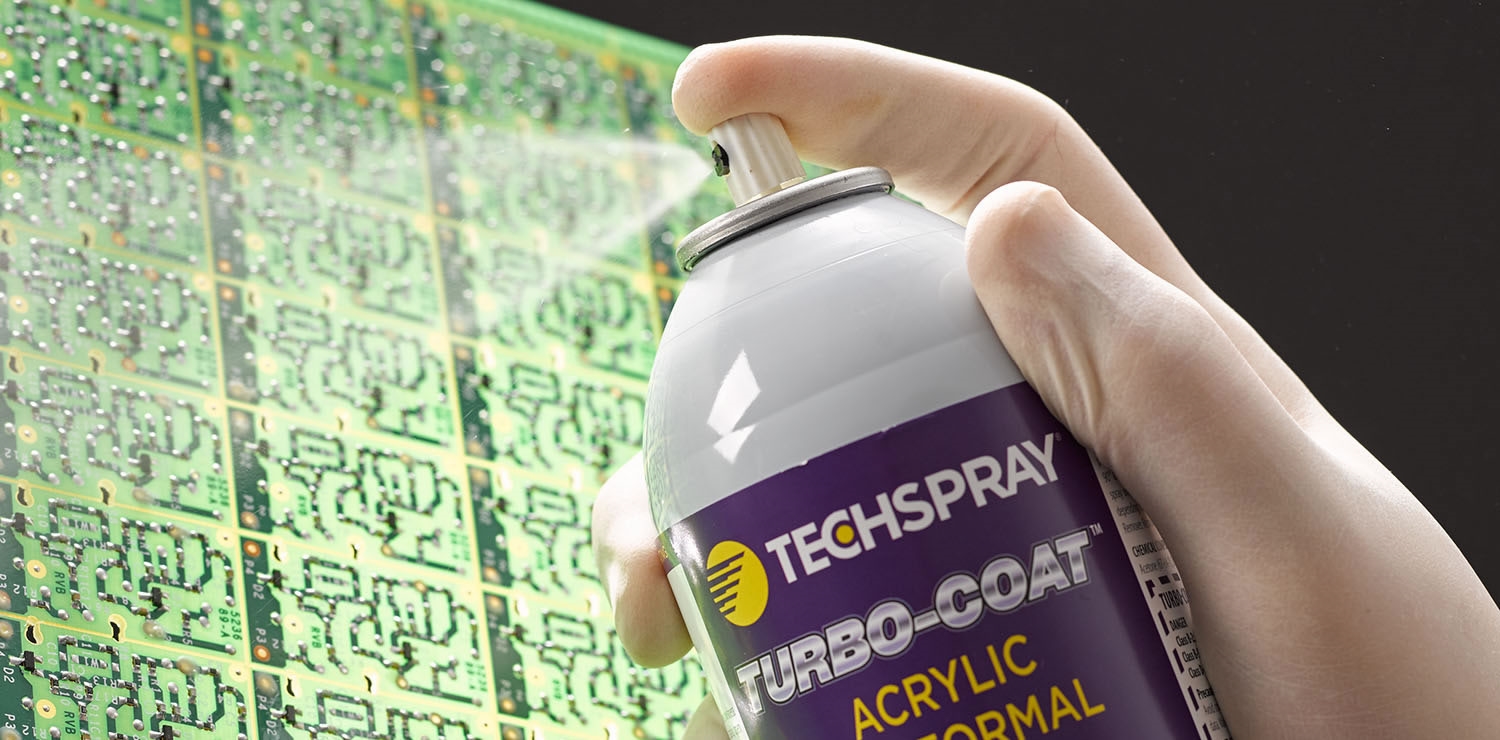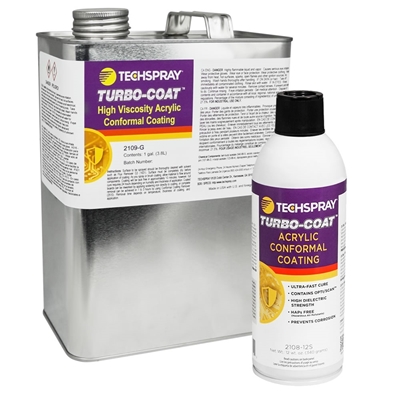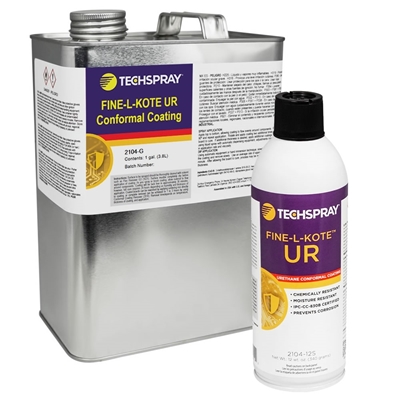Hi, I’m Nicole Bass, Product Manager for Techspray conformal coatings.
Today I am going to take you through the most common questions I receive from customers that are setting up a coating process.
A conformal coating is a thin layer of polymer applied to electronic components or circuit boards to protect them from environmental factors like moisture, dust, chemicals, and mild mechanical stress.
The goal of conformal coating is to increase durability and improve reliability of electronic devices, which will extend their life in harsh environments.
They are commonly used in various industries, including electronics, automotive, aerospace, medical electronics and many more.
What are the main types of conformal coatings?
Conformal coatings are categorized by their base resin, the material left behind once the carrier solvents evaporate off.
The chemical composition of each conformal coating determines its main attributes and protective properties. The best coating for your application is determined by the operational requirements of your electronics.
Acrylic Resin or “AR” is the most economical conformal coating option, and provides good general protection. Generally, acrylic coatings have high dielectric strength, and fair moisture and abrasion resistance.
Acrylic coatings are easily and quickly removed by a variety of solvents, often without even having to scrub. This makes rework and even field repair very practical and inexpensive.
On the other hand, acrylic coatings do not protect against solvents and solvent vapors, so they are not ideal for applications that could come into contact with fuel or solvent vapor.
Silicone Resin or “SR” : provides excellent protection in a very wide temperature range.
Silicone provides good chemical resistance, moisture resistance, and is very flexible. Silicone conformal coating is not abrasion resistant because of its rubbery nature, but this property does make it resilient against vibrational stresses. Silicone coatings are commonly used in high-humidity environments.
Optically clear silicone coating is available that can coat LED lights without color shift or reduction of intensity.
Removal can be more challenging than acrylic, requiring specialized solvents, long soak time, and agitation from a brush or an ultrasonic bath.
Urethane Resin or “UR” has excellent moisture and chemical resistance, and can also withstand abrasion better than other types of coatings. Because urethanes are solvent resistant, they can be very difficult to remove. Like silicone, full removal generally requires special solvents, long soak times, and agitation with a brush or an ultrasonic bath. Urethane conformal coating are commonly specified for aerospace application where exposure to fuel vapors is a common concern.
Those are the most common conformal coatings that have been in use for decades. Others are used for specialized applications:
- Epoxy Conformal Coating is common for encapsulating or “potting” electronics. This is often required when a device will be fully submerged in water for any length of time.
- Parylene Conformal Coating is applied using vapor phase deposition. It is considered top-of-the-line, so is the most expensive option, and most difficult to rework. As you might expect, this is most common for aerospace and medical device applications.
- Thin Film or “Nano” Coatings provide a water repellant layer for “good enough” protection needed for some consumer electronics.
When is conformal coating necessary?
Whether or not conformal coating is required depends on the environment the electronic device will operate in, the reliability requirement of the device, and the cost of failure, whether in dollars or human lives. Devices operating in harsh environments may require coating, and the type of stresses and contamination will point to the best option, whether that is acrylic resin (AR), silicone resin (SR), urethane resin (UR), or some other type of protection. Aviation, aerospace, and medical devices often require coating because of their mission critical nature.
Does your conformal coating meet IPC-CC-830?
Yes, all Techspray coatings meet IPC-CC-830 standards. IPC-CC-830 defines the requirements for conformal coatings, used to protect printed circuit boards and electronic assemblies from environmental factors such as moisture, dust, chemicals, and temperature extremes. The standard outlines the testing methods and performance criteria to meet industry requirements. You might see IPC-CC-830B, 830C, etc. The extra letter refers to the revision. The changes between revisions general do not affect all types of coatings, so coatings are often not retested to the latest standard.
MIL-I-46058 was a military specification for electrical insulating compounds used on electronics, and has been replaced by the civilian industrial standard IPC-CC-830.
Is conformal coating waterproof?
While conformal coatings can offer a moisture resistant layer of protection, most cannot be considered waterproof. Even if applied heavily, most coatings are semi-permeable, therefore will allow some amount of moisture through. Conformal coating can, however, prevent current leakage or corrosion due to ambient moisture. To truly waterproof electronics, you either need gasketing to seal the electronics within the packaging or cover the electronics with a waterproof encapsulant or potting compound.
Does conformal coating protect against ESD (also known as static)?
While conformal coatings can offer some level of protection against ESD by providing a barrier between the sensitive electronic components and the surrounding environment, they are not specifically designed as ESD control measures.
How long does conformal coating take to cure?
The drying and curing time of conformal coatings can vary depending on the type of coating used, thickness and the environmental conditions like temperature and humidity. Acrylic coatings typically dry quickly, and the initial tack-free time can be anywhere from a few minutes to an hour. Full curing time can range from 24 to 72 hours. Silicone coatings usually have a longer tack-free time, which can take several hours, and complete cure time can vary from 12 hours to a few days. Urethane coatings have a relatively fast tack-free time, often within a few minutes, but full cure might take 24 to 48 hours.
Curing can generally be accelerated by running the boards through an oven. The actual temperature depends on the coating, but please note these will be well below reflow temperature. Some coatings might require a 2-step cure approach or a temperature ramp-up that allows the coating to level properly.
How do you apply conformal coating to a printed circuit board (also known as a PCB)?
Prepare the PCB
Ensure the PCB is clean, dry, and free from any contaminants. Clean it using an appropriate PCB cleaning solution or isopropyl alcohol to remove any dirt, flux residues, or other impurities that could interfere with the coatings adhesion.
Select the Conformal Coating
There are various types of conformal coatings available, such as acrylic (AR), silicone (SR), and urethane (UR). Choose a coating that suits your specific application and environmental conditions.Masking Uncoated Areas: If certain components or areas on the PCB should remain uncoated (e.g., connectors, switches, or heat sinks), use a masking material (e.g., Kapton tape or liquid latex) to protect those areas during the coating process.
Choose the Application Method:
Conformal coatings can be applied using different methods, including spraying, dipping, brushing, or dispensing. The method you choose depends on the type of coating and your equipment's capabilities.
- Spraying: Suitable for large-scale production. It requires a specialized spray booth and spray gun to evenly apply the coating.
- Dipping: Involves immersing the entire PCB into a reservoir of conformal coating. This method provides uniform coverage but may trap air bubbles.
- Brushing: This is a Manual application using a brush it’s suitable for small-scale production or touch-ups.
- Machine dispensing: This applies the coating using a controlled dispensing system, which is useful for selective coating on specific areas of the PCB.
Curing and Drying
Allow the applied conformal coating to cure and dry as per the manufacturer's instructions. This typically involves leaving the coated PCB in a controlled environment, such as an oven, for the recommended duration of time.
Post-Coating Inspection
After the coating has cured, inspect the PCB to ensure proper coverage and to check for any defects, such as bubbles, pinholes, or insufficient coating.
How Do You Measure The Thickness of The Final Coating?
There are several methods used to measure the thickness, and the choice of method may depend on the type of conformal coating and the level of accuracy required.
- Caliper: This is the simplest and cheapest method , to use a caliper to measure the thickness of the PCB before and after coating.
- Calibrated Thickness Gauges: These are handheld devices that use non-destructive methods to measure the thickness of the coating. They typically use magnetic induction or eddy current principles to determine the distance between the probe and the substrate, which correlates to the coatings thickness.
- Cross-Sectioning and Imaging: This method involves cutting a sample of the coated surface and examining it under a microscope. The thickness can be determined by measuring the height of the coating in the cross-sectional view.
- Ultrasonic Testing: Ultrasonic thickness gauges use sound waves to measure the thickness of the coating. The device emits ultrasonic pulses, and the time taken for the waves to bounce back from the substrate-coating interface is then used to calculate the thickness.
- X-ray Fluorescence (or XRF): XRF can be used to measure the thickness of conformal coatings. It involves analyzing the intensity of X-rays emitted from the coating material due to bombardment by X-rays. The thickness is determined based on the X-ray’s penetration depth.
- Electrical Capacitance Method: This method utilizes the change in capacitance between electrodes positioned on opposite sides of the coated surface. The coating's thickness affects the capacitance, allowing for indirect measurement.
How can you double-check your conformal coating coverage?
Conformal coating with UV tracer can be inspected with any typical UV lamp, also called a “black light”, which has a wavelength of 320-380 nanometers. When you have full coverage, it glows bright. Shadowed areas, pinholes, and other gaps will show up as dark areas.
How do you remove conformal coating when repairing or reworking a PCB?
Techspray offers the TraceTech Conformal Coating Remover Pen that allows you to remove a tight area of coating around a repair area without affecting the rest of the PCB. You first saturate the tip by tapping it lightly on a surface, which opens the valve and releases solvent. Holding the tip down may oversaturate it, which could lead to solvent flowing into unintended areas.
Coating can also be removed completely from a circuit board by soaking it in Techspray’s Conformal Coating Remover or Conformal Coating Remover XT, and scrubbing as necessary. Acrylic coating will come off easily, while silicone and especially urethane will take longer soak times and alot more scrubbing.
I hope all this information on conformal coating has been helpful to you.
Remember, Techspray offers state-of-the-art cleaning, coating and analytical services to help you qualify new products and optimize your processes. This is offered free of charge if you are considering one of our products. Please contact Techspray when you are ready to get started.







